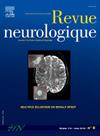Adding corticosteroids to galcanezumab in medication overuse headache: A three-arm head-to-head prospective observational cohort study
IF 2.8
4区 医学
Q2 CLINICAL NEUROLOGY
引用次数: 0
Abstract
Background
Medication overuse headache (MOH) is a condition where pain relief medications cause chronic headaches due to excessive use. Recent advancements highlight the effectiveness of preventive treatments like anti-CGRP monoclonal antibodies. Current strategies combine medication withdrawal and preventive treatments, with corticosteroids traditionally used to ease withdrawal symptoms.
Methods
This is a prospective three-arm observational cohort study comparing the effectiveness and safety of galcanezumab alone, galcanezumab plus prednisone and prednisone alone for the treatment of MOH. We enrolled 75 patients. Prednisone was administered at an initial dose of 50 mg daily, and then tapered off over 28 days. Duration of follow-up was 3 months.
Results
All treatments proved effective (P < 0.001). We found a significant reduction of mean monthly days with headache in the galcanezumab plus prednisone group (baseline: 25, IQR: 20–30; after 3 months: 7, IQR: 5–10), in the galcanezumab group (baseline: 25, IQR: 20–30; after 3 months: 10, IQR: 5–14) and in the Prednisone group (baseline: 25, IQR: 20–28; after 3 months: median: 15 days, IQR: 8–22 days). Patients treated with prednisone reported a higher incidence of side effects (P = 0.002).
Conclusion
Our study indicates that both galcanezumab and prednisone decrease the frequency of headaches in patients with MOH. The combined usage of these treatments showed the highest reduction in mean monthly headache days. However, treatment with prednisone determined a significant rate of adverse events, therefore we suggest its use only in unresponsive patients. In all other patients galcanezumab appears to be a safe and effective option.
在治疗药物滥用性头痛时,在加坎儿珠单抗中加入皮质类固醇:三臂头对头前瞻性观察队列研究。
背景:药物过度使用性头痛(MOH)是一种因过度使用止痛药物而导致慢性头痛的病症。最近的研究进展突显了抗 CGRP 单克隆抗体等预防性治疗的有效性。目前的策略是将停药和预防性治疗结合起来,传统上使用皮质类固醇来缓解停药症状:这是一项前瞻性三臂观察性队列研究,比较了单用加奈珠单抗、加奈珠单抗加泼尼松和单用泼尼松治疗MOH的有效性和安全性。我们共招募了75名患者。泼尼松的初始剂量为每天50毫克,然后在28天内逐渐减量。随访时间为 3 个月:结果:所有治疗方法均有效(PC结论:所有治疗方法均有效:我们的研究表明,加康珠单抗和泼尼松都能降低MOH患者的头痛频率。联合使用这两种疗法后,每月平均头痛天数的减少幅度最大。然而,使用泼尼松治疗会产生大量不良反应,因此我们建议仅在无反应的患者中使用。对于所有其他患者,加康珠单抗似乎是一种安全有效的选择。
本文章由计算机程序翻译,如有差异,请以英文原文为准。
求助全文
约1分钟内获得全文
求助全文
来源期刊

Revue neurologique
医学-临床神经学
CiteScore
4.80
自引率
0.00%
发文量
598
审稿时长
55 days
期刊介绍:
The first issue of the Revue Neurologique, featuring an original article by Jean-Martin Charcot, was published on February 28th, 1893. Six years later, the French Society of Neurology (SFN) adopted this journal as its official publication in the year of its foundation, 1899.
The Revue Neurologique was published throughout the 20th century without interruption and is indexed in all international databases (including Current Contents, Pubmed, Scopus). Ten annual issues provide original peer-reviewed clinical and research articles, and review articles giving up-to-date insights in all areas of neurology. The Revue Neurologique also publishes guidelines and recommendations.
The Revue Neurologique publishes original articles, brief reports, general reviews, editorials, and letters to the editor as well as correspondence concerning articles previously published in the journal in the correspondence column.
 求助内容:
求助内容: 应助结果提醒方式:
应助结果提醒方式:


